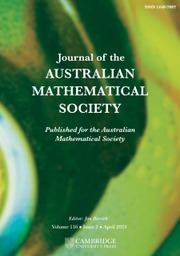No CrossRef data available.
Article contents
Manifolds that fail to be co-dimension 2 fibrators necessarily cover themselves
Part of:
Low-dimensional topology
Classical Topics in Algebraic Topology
Basic constructions
Topological manifolds
Published online by Cambridge University Press: 09 April 2009
Abstract
Core share and HTML view are not available for this content. However, as you have access to this content, a full PDF is available via the ‘Save PDF’ action button.
Let N be a closed s-Hopfian n-manifold with residually finite, torsion free π1 (N) and finite H1(N). Suppose that either πk(N) is finitely generated for all k ≥ 2, or πk(N) ≅ 0 for 1 < k < n – 1, or n ≤ 4. We show that if N fails to be a co-dimension 2 fibrator, then N cyclically covers itself, up to homotopy type.
- Type
- Research Article
- Information
- Copyright
- Copyright © Australian Mathematical Society 2003
References
[2]Chinen, N., ‘Products of manifolds with nonzero Euler characteristic and co-dimension 2 fibrators’, preprint.Google Scholar
[3]Coram, D. S. and Duvall, P. F., ‘Approximate fibration’, Rocky Mountain J. Math. 7 (1977), 275–288.CrossRefGoogle Scholar
[4]Coram, D. S. and Duvall, P. F., ‘Approximate fibration and a movability condition for maps’, Pacific J. Math. 72 (1977), 41–56.CrossRefGoogle Scholar
[5]Coram, D. S. and Duvall, P. F., ‘Mappings from S3 to S2 whose point inverses have the shape of a circle’, General Topology Appl. 10 (1979), 239–246.CrossRefGoogle Scholar
[6]Daverman, R. J., ‘Hyper-Hopfian groups and approximate fibrations’, Compositio Math. 86.Google Scholar
[7]Daverman, R. J., ‘Submanifold decompositions that induce approximate fibrations’, Topology Appl. 33 (1989), 173–184.CrossRefGoogle Scholar
[8]Daverman, R. J., ‘3-manifolds with geometric structure and approximate fibrations’, Indiana Univ. Math. J. 40 (1991), 1451–1469.CrossRefGoogle Scholar
[9]Daverman, R. J., ‘Co-dimension 2 fibrators with finite fundamental groups’, Proc. Amer Math. Soc. 127 (1999), 881–888.CrossRefGoogle Scholar
[10]Daverman, R. J., ‘Hyperbolic groups are hyper-Hopfian’, J. Aust rat. Math. Soc. (Series A) 68 (2000), 126–130.CrossRefGoogle Scholar
[11]Daverman, R. J., Im, Y. H. and Kim, Y., ‘Products of Hopfian manifolds and co-dimension 2 fibrators’, Topology Appl. 103 (2000), 323–338.CrossRefGoogle Scholar
[12]Daverman, R. J. and Kim, Y., ‘2-groups and approximate fibrations’, Topology Appl., to appear.Google Scholar
[13]Epstein, D. B. A., ‘Degree of a map’, Proc. London Math. Soc. 16 (1966), 369–383.CrossRefGoogle Scholar
[14]Hausmann, J. C., Geometric Hopfian and non-Hopfian situations, Lecture Notes in Pure Appl. Math. (Marcel Decker, NY, 1987) pp. 157–166.Google Scholar
[15]Hirshon, R., ‘Some properties of endomorphisms in residually finite groups’, J. Austral. Math. Soc. (Series A) 24 (1977), 117–120.CrossRefGoogle Scholar
[16]Im, Y. H. and Kim, Y., ‘Hopfian and strongly Hopfian manifolds’, Fund. Math. 159 (1999), 127–134.CrossRefGoogle Scholar
[17]Im, Y. H. and Kim, Y., ‘Necessary and sufficient conditions for s-Hopfian manifolds to be co-dimension 2 fibrators’, Proc. Amer Math. Soc. 129 (2001), 2135–2140.CrossRefGoogle Scholar
[18]Kim, Y., ‘Manifolds with hyper-Hopfian fundamental group as co-dimension 2 fibrators’, Topology Appl. 96 (1999), 241–248.CrossRefGoogle Scholar
[19]Kim, Y., ‘Strongly Hopfian manifolds as co-dimension 2 fibrators’, Topology Appl. 92 (1999), 237–245.Google Scholar
[20]Maunder, C. R. F., ‘A short proof of a theorem of Kan and Thurston’, Bull. London Math. Soc. 13 (1981), 325–327.CrossRefGoogle Scholar
[21]Munkres, J. R., Elements of algebraic topology (Addison-Wesley, Menlo Park, CA, 1984).Google Scholar
[23]Swarup, G. A., ‘On a theorem of C. B. Thomas’, J. London Math. Soc. 8 (1974), 13–21.CrossRefGoogle Scholar


